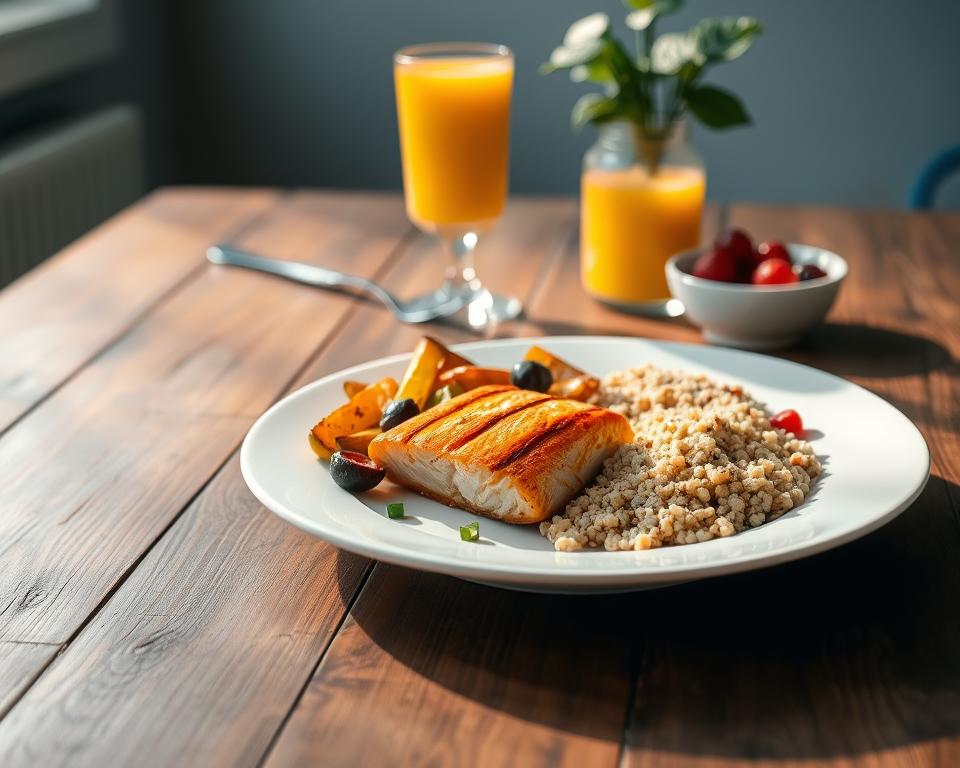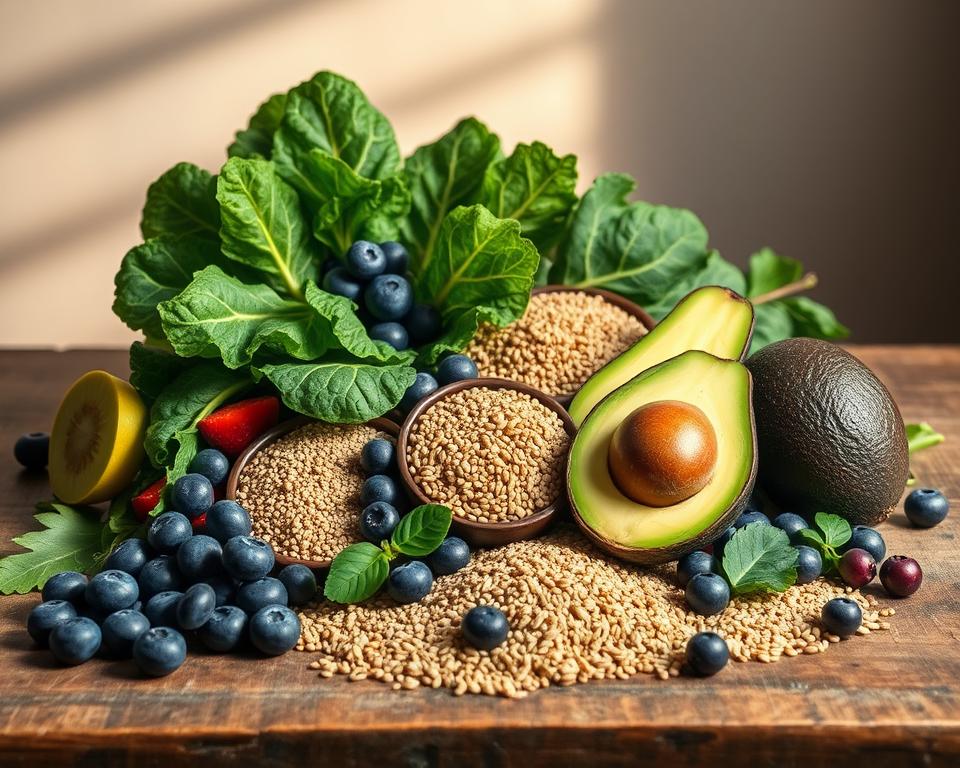Anúncios
Balanced nutrition matters when you want steady energy and clear focus through your day.
In this friendly guide you’ll learn a simple, plate-based approach that matches current expert advice from Harvard and USDA. Use half your plate for colorful produce, one-quarter for whole grains, and one-quarter for protein, with healthy oils and water, tea, or coffee with little added sugar.
Think practical, cultural, and tasty. We’ll show quick plate builds, smart grocery swaps like brown rice for white, and easy ways to enjoy coffee without extra calories. This helps your body and mind feel steady, rather than chasing numbers alone.
You’ll get flexible tips you can use at home, work, or on the go, plus reminders to adapt plans to your needs and consult qualified professionals for personal advice.
Introduction: Why balanced nutrition powers your day
You can power work, study, and play with meals built from familiar ingredients and a few clear rules. This approach helps keep energy steady and focus clearer across busy mornings, meetings, and evenings.
Anúncios
Context and relevance for everyday eating
Think practical: quick breakfasts, portable lunches, and simple dinners can steady your energy without complex tracking. Many people overestimate how close their plate is to recommended patterns, so small swaps work well.
What “balanced” means in simple terms
In plain terms, a balanced diet is about proportions and quality: half your plate produce, a quarter whole grains, and a quarter protein, with healthy oils and water-first beverages. Emphasize variety across colors and food types so you cover a broad range of nutrients without chasing numbers.
How this guide helps you put ideas into practice
This guide turns research-based recommendations into usable, culturally flexible steps you can try at home, at work, or on a budget. It highlights small changes—adding another vegetable or swapping refined for intact grains—that fit different needs and activity levels.
Anúncios
Note: These tips support healthy eating habits and food culture; consult a registered dietitian for personalized diet advice.
From willpower to meal power: Quality of foods over calories alone
Swap willpower for smart meal choices: the type of foods you eat matters more than calorie totals.
Think plate, not points. Aim for half your plate with produce, a quarter with whole grains, and a quarter with protein. This view, used by experts, favors the kind of carbohydrate over strict portion math.
The plate perspective: more produce, better variety
Choose a produce-forward plate. Different colors bring fiber and micronutrients that help you feel full and steady between meals.
Choosing nutrient-dense foods to avoid energy slumps
Pick intact grains like oats, quinoa, or brown rice and combine them with beans or lean fish. These choices slow the blood-sugar rise so your focus doesn’t crash in the afternoon.
“Half vegetables and fruits, a quarter whole grains, and a quarter protein creates steadier energy for many people.”
- Cook with olive or canola oil for flavor and lasting satiety.
- Avoid sugary drinks; water, tea, or coffee with little sugar work best.
- Remember: potatoes and fries behave like starches, not non-starchy vegetables.
Aim for variety over the week, not perfection at every meal. Small swaps and colorful plates add up to better nutritional value and lasting health.
Use the plate method to build meals that sustain focus
One simple plate helps you build any meal that supports steady energy and clear thinking. Aim for color, whole foods, and small changes you can keep up every day.
Half your plate: colorful vegetables and fruits
Fill half your plate with non-starchy vegetables and fruits. Think leafy greens, peppers, tomatoes, and berries.
These front-load fiber and vitamins so your energy is steadier between meals.
One quarter: whole grains for steady carbs
Reserve a quarter of the plate for whole, intact grains like quinoa, farro, or brown rice. These grains slow digestion and help focus.
One quarter: protein that supports brain and body
Add a quarter plate of healthy protein—grilled fish, beans, tofu, or baked chicken. Limit processed meats and large portions of red meat.
Oils and drinks: small additions with big effects
Cook or dress with olive or canola oil and add a few nuts or seeds for texture. Sip water, tea, or coffee with little or no sugar.
- Use bowls or wraps the same way: half produce, quarter grains, quarter protein.
- Keep quick grains and canned beans on hand to build plates fast.
Tip: Treat the plate as a flexible template you can adapt while following expert recommendations for a healthy eating pattern.
Carbohydrates done right: whole grains and smart starches
Swapping refined carbs for whole and intact grains can help you stay focused longer.
Choose intact grains like oats, quinoa, and brown rice to slow digestion and temper blood sugar rises. These grains keep the bran and germ, which add fiber and nutrients that help steady energy between meals.
Refined vs. whole: why fiber and intact grains matter
Whole grains release glucose more slowly than refined versions. That milder effect on blood sugar and insulin supports steadier attention and fewer mid-afternoon dips.
Where starchy vegetables fit on your plate
Put starchy vegetables—potatoes, corn, peas—into the grains/starch quarter of your plate, not the vegetable half. This keeps your vegetable portion focused on non-starchy choices that add fiber and color.
Practical swaps for everyday meals
- Swap brown rice for white rice and whole-wheat pasta for regular pasta.
- Use barley or farro in soups instead of refined noodles.
- Mix quinoa and brown rice to vary texture while boosting fiber.
- Prep a batch of grains for quick weeknight meals and pair them with veggies and protein.
Read labels for “100% whole” and grain names like oats or brown rice at the top. For more on choosing whole grains, see whole grains.
Protein choices that work for your body and brain
Choose protein that fuels your day and keeps meals satisfying. Aim for about a quarter of your plate from protein at each meal so you feel full and steady between snacks.
Lean and plant-forward options
Pick a mix of animal and plant proteins. Fish and poultry cook quickly and pair well with vegetables.
Plant-forward picks like tofu, tempeh, lentils, and beans add fiber and variety.
How much at meals: a practical quarter-plate guide
Visual cue: reserve one quarter of your plate for protein. That portion fits a palm-sized fillet, a cup of beans, or a scoop of tofu.
- Lean choices: salmon, trout, skinless poultry, canned tuna or salmon.
- Plant choices: black beans in tacos, lentils in soups, edamame and mixed nuts.
- Prep hack: batch-cook a pot of beans for salads, wraps, and quick bowls all week.
Limiting red meat and avoiding processed meats
Limit red meat portions and choose lean cuts when you include them. Avoid processed meats like bacon, sausage, and deli cold cuts except rarely.
Combine your protein with plenty of vegetables and whole grains so flavors balance and portions stay in check. Your diet, tastes, and activity level will shape exact needs—use the plate as a flexible guide.
Fats that help, fats to limit
Fats shape flavor and satiety. They also help the rest of your plate feel more satisfying without extra rules.
Cook and dress with plant oils
Use olive, canola, soybean, sunflower, or peanut oil for everyday cooking and dressings. These unsaturated fats bring flavor and help vegetables and grains shine.
Saturated fat and why trans fats are out
Keep butter, cream, and coconut in modest amounts—those are common sources of saturated fats. Avoid foods with “partially hydrogenated” on the label; that phrase signals trans fats to skip.
Portion cues without fearing fat
Use a spoon or two of oil for sautéing and a small handful of nuts as a topping. Add avocado or seeds to bowls for texture and pleasure.
- Balance flavors: a drizzle of olive oil and lemon can replace heavy sauces.
- Read ingredient lists to spot hidden trans fats.
- Let overall plate proportions guide choices more than low-fat labels.
Tip: Focus on food quality and simple swaps to support your balanced diet and daily healthy eating goals without counting grams.
Hydration, caffeine, and sugar: your daily drink strategy
Sip smart: what you drink shapes focus and adds—or subtracts—calories across the day.
Water first: make water your default. Carry a reusable bottle and set gentle reminders to sip, especially during long work stretches. Use thirst and pale urine color as simple cues that you’re drinking enough.
Coffee and tea with little or no sugar
Enjoy coffee and tea but limit added sugar. Try cinnamon, vanilla extract, or a splash of milk for flavor instead of syrups. Time caffeine earlier so it supports attention without messing with sleep.
Limit dairy and juice; avoid sugary drinks
Keep dairy to about 1–2 servings per day if it fits your preferences. Treat juice as a small glass—not a full drink—and skip sugary beverages like soda, energy drinks, and sweetened teas. These products add calories with little benefit.
Practical swaps and quick rules
- Pair meals with water first; let your plate provide flavor and fullness.
- Try sparkling water with citrus or iced herbal teas for variety.
- Read labels—some bottled teas and juices hide several teaspoons of sugar.
Tip: adapt to climate and activity. Hydration needs vary, so adjust intake across the day while keeping drinks simple for steady energy and clear focus.
Balanced nutrition in action: meal timing and plate-building tips
Plan simple timing and plates so your energy and focus feel steady all day. Aim for regular meals and, if helpful, one planned snack to avoid dips in attention.

Regular meals and snacks to keep energy even
Eat every 3–4 hours. That pattern helps steady blood sugar and keeps you alert.
Tip: schedule breakfast, lunch, dinner, and a mid-afternoon snack when your workday is long.
Easy templates for breakfast, lunch, and dinner
- Breakfast: half produce (fruit or veg), a quarter grains (oats or whole toast), a quarter protein (eggs, yogurt, tofu).
- Lunch: pack a bowl: half vegetables, a quarter grains (quinoa or brown rice), a quarter protein (beans, chicken, fish).
- Dinner: roast a tray of vegetables, cook a quick grain, and add a protein like lentils, tofu, or baked fish.
Snack hacks: pair two food groups—fruit + nuts, veggies + hummus, or yogurt + oats—for lasting fullness.
- Batch-prep chopped vegetables, cooked grains, and a pot of beans to save time.
- Use frozen vegetables, canned fish, and precooked grains as practical sources for fast meals.
- Rotate ingredients weekly to vary nutrients and keep healthy eating enjoyable.
Labels, portions, and variety: practical skills for the grocery aisle
Quick label checks and simple portion cues can make grocery trips stress-free and help you shop smarter. Use a few clear rules to pick foods that support steady energy and easy meal prep.
Scan for whole grains, added sugar, and trans fats
Turn packages to read the ingredient list before you grab them. Look for “100% whole” and grain names like whole wheat, oats, or brown rice near the top.
- Check sauces, yogurts, and cereals for added sugar and choose unsweetened options when possible.
- Avoid products that list “partially hydrogenated oils” to skip trans fats.
- Pick minimally processed items most of the time; save ultra-processed snacks for treats.
- Limit deli cuts and cured items—processed meats are best for rare occasions.
Right-size portions without counting every calorie
Use your plate as the portion guide: half vegetables, a quarter grains, a quarter protein. This handles the amount and food groups without math.
- Compare sodium and sugar across similar products to find lower options.
- Stock staples: frozen vegetables, canned beans (no salt), canned fish, whole-grain breads and pastas.
- Try one new whole-grain product each trip to expand variety while keeping costs down.
Tip: Simple label skills and plate portions make it easy to follow a balanced diet and support healthy eating at home.
Balanced nutrition and the planet: eat well, choose wisely
Simple plate choices can help you eat well and make gentler choices for the planet. Small swaps keep meals tasty and practical.
More plants, fewer processed meats, and mindful oils
Lean into plant-forward plates: more vegetables, beans, and whole grains often mean fewer resource-heavy foods at meals.
Limit processed meats and enjoy smaller portions of red meat. Try legumes, tofu, or fish for variety across the week.
Choose fats thoughtfully. Olive and canola work well for dressings and cooking and match Healthy Eating Plate guidance.
- Let vegetables lead—roast, sauté, or make herb-rich slaws first.
- Use “meat as a flavor” in stir-fries and stews so pulses and veg take center stage.
- Reduce waste: plan meals, use leftovers, and store ingredients for next-day lunches.
Respect culture: tweak proportions—more veg and legumes, modest meat—without losing familiar tastes. These steps support a healthy diet that helps your health and your body while you enjoy the foods you love.
Foodtech tools that make a healthy balanced plate easier
Digital tools plus a short prep routine help you build reliable, ready-to-eat plates. Use apps and a few kitchen habits so healthy eating fits your schedule, not the other way around.
Using MyPlate Plan and shopping apps
Start with the USDA MyPlate Plan to personalize portions by height, weight, age, and activity. It gives simple recommendations like half fruits/vegetables, a quarter grains, a quarter protein, and about 3 cups dairy per day.
Try grocery apps with barcode scanners to compare whole-grain content, added sugars, and ingredients quickly. These apps speed shopping and help you pick products that match your goals.
Batch cooking, smart storage, and quick-cook grains
Pick two grains (quick brown rice, whole-wheat couscous), two proteins (tofu, beans), and three vegetables to rotate each week. Batch-cook grains and beans on the weekend and store them in clear containers for fast assembly.
- Keep a “prep box” of cut vegetables and a jar of olive-oil vinaigrette for salads that hit half your plate.
- Use freezer-friendly staples: frozen vegetables, edamame, and whole-grain breads for busy days.
- Compare dairy and dairy products labels to choose options without hidden sugars.
Tip: build a “balanced plate shelf” in your pantry with whole grains, canned beans, canned fish, olive oil, vinegars, and spices. Set gentle calendar reminders for water breaks and produce restocks.
Track patterns, not perfection: note how different food groups and timing affect your energy and adjust with simple swaps. If you need personalized advice, consult a qualified professional.
Conclusion
Small, repeatable food choices can make your day feel more productive and less scattered. , use a simple plate: fill half with vegetables and fruit, then round out with whole grains and protein so your meals support steady energy and clearer focus.
Keep variety in mind—rotate colors, cuisines, grains like brown rice, and beans or fish for protein. Favor minimally processed products and cook with unsaturated fats like olive oil to boost flavor and nutritional value without extra rules.
Right-size portions with the half/quarter/quarter plate instead of counting calories. Enjoy dairy in ways that suit you, limit processed meats, and let water, tea, or coffee with little sugar be your main drinks.
Make changes slowly and personalize with tools like MyPlate Plan or a registered dietitian’s help for weight, blood, or medical questions. Explore food culture consciously and build a healthy eating pattern that fits your life.



